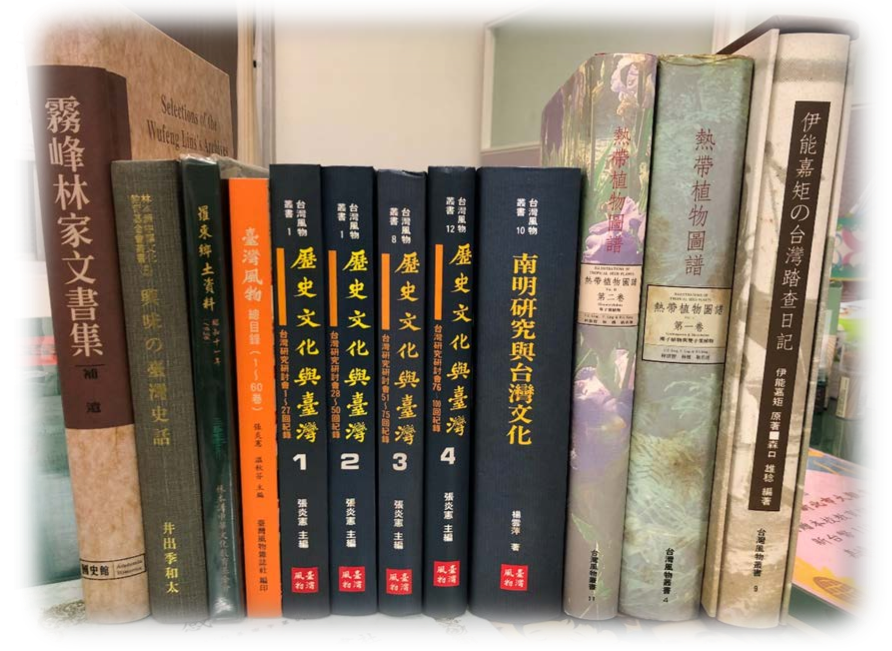
史上最初的台灣獨立運動: 台灣民主國
The Taiwan Republic: The First Ever Taiwan Independence Movement?
林呈蓉/Lin Cheng-rong
(淡江大學歷史系副教授)
(Associate Professor, Department of History, Tam-kang University )
2001-05-28
 The national flag of Taiwan Republic– an amber tiger on blue ground
The national flag of Taiwan Republic– an amber tiger on blue ground
1895年,大清帝國於甲午戰爭中敗於日本,因此將台灣割讓與日本。台灣民主國在此歷史背景下成立,號稱為亞洲第一個民主共和國,作為反抗日本殖民統治的手段。然而台灣民主國成立不久在各種歷史因素下旋告解體。本週我們邀請到淡江大學歷史系副教授林呈蓉針對台灣民主國的沿革興亡及歷史意義作深入的探討。
Taiwan was ceded to Japan in 1895 as a resultof the Ching Empire’s defeat in the Chia-wuWar. In the aftermath of this the TaiwanRepublic was proclaimed, which served to rallyresistance against Japanese colonization andwas heralded as Asia’s first democraticrepublic. Shortly after its establishment,though, the Taiwan Republic was to collapsedue to various historical factors. This weekwe ask Professor Lin Cheng-rong of theDepartment of History, Tam-kang University,to present a detailed account of the rise andfall of the republic and an in-depth analysisof its historical significance.
1895年,大清國與日本之間為了爭奪朝鮮半島的經濟勢力爆發了甲午戰爭(或稱日清戰爭),清國大敗,而以馬關條約議和,清國同意將台灣、澎湖及遼東半島等地割讓給日本。
The 1894-95 Chia-wu War (or the Sino-JapaneseWar) was fought between the Ching Empireand Japan to settle their contest foreconomic dominance on the Korean Peninsula.Ching was soundly beaten and forced to signthe Treaty of Shimonoseki, in which itagreed to cede Taiwan, the Pascadores, andthe Liao-tung Peninsula to Japan.
割讓前夕人心惶惶
割讓台灣的消息透過洋行、外國商人的口耳相傳,台灣的住民皆感到震驚譁然。令他們百思不得其解的是,整個戰役的場景發生在中國的北方,但為何卻要割讓南方的領土。由於清國官方並沒有將割讓的消息正式告知台灣民眾,因此地方上的仕紳便推派代表向當時的台灣巡撫唐景崧求證,並表達誓死與日本對抗的決心。 唐景崧原本私下準備潛行回大陸,但面對地方仕紳的「劫留」,頓時感到騎虎難下,乃將此地的情勢電告清廷,謀求對策。當時的南洋大臣張之洞便以幾個原則提示唐景崧,強調台灣的反抗無論是自立救助、或是結以外援,都必須在與清國無關的前提下,以台灣「自保」的名義、或民眾「意願、從違」的形式,從事抗爭活動。
Pervasive Panic Prior to the Cession
As word-of-mouth news of the island’scession was spread through foreign firmsand merchants, inhabitants in Taiwan wereovertaken by surprise and driven to atumult. They were dumbfounded by theseeming absurdity that, while all thebattles had been engaged in the north ofChina, the aftermath was regardless thecession of a southern territory. Since theimpending relinquishment was not formallymade public to the residents of Taiwan,representatives of the local gentry had toseek forits confirmation from Tang Ching-sung,then the Governor of Taiwan. At the same time,they expressed their resolution to fightagainst Japan to the bitter end. On the sly Tang had planned to sneak backto the mainland, but pretty soon he foundhimself in a tight spot as he was “abductedand detained” by the gentry. In the event,he telegraphed to the Ching court a reporton local conditions and a request for adviceon responding measures. Chang Chih-tung, theGovernor-general at Nanking, replied andordered Tang to follow several generalguidelines. The resistance should be conducted,it was emphasized, without implicating theChing government; whether the movement was forself-reliant deliverance or was to solicitoutside assistance, it should be attempted onlyin the name of Taiwan’s “self-protection,” orpursuant to the public’s “willingness to followor the lack thereof.”

The beheaded local soldiers
台灣巡撫電告清廷將獨立建國
在與地方仕紳商議之後,唐景崧便電告清廷,報備此處將以「獨立建國」的名義謀求自立。並於該年 5月23日發表「台灣民主國自主宣言」,這個號稱是「東亞第一個民主共和國」的「台灣民主國」就這樣產生。以唐景崧為總統、丘逢甲為副總統兼民兵司令官、俞明震任內務部長、李秉瑞任國防部長、劉永福任南部守備大將、國會議長則推林維源擔任(不過他沒有就任便潛行回大陸去了)。
Intention for Independence Declared by theGovernor
After consultation with the local gentry,Tang sent a telegraph to the Ching court,proposing that the territory should endeavorfor self-reliance in the manner of an”independent nation.” ON May 23, 1895, the”Autonomy Declaration of the TaiwanRepublic” was announced, and thus was broughtinto existence the “Taiwan Republic”-heraldedas the first democratic republic of East Asia.Tang himself assumed the office of itsPresident, with Chiu Feng-chia as theVice-president and Militia Commander; YuMing-tsen the Interior Minister; Lee Ping-reithe Defense Minister;; Liu Yung-fu theBrigade-general of the South; and Lin Wei-yuanthe Chairman of the Parliament (although heslipped back to the mainland before taking theoffice).
有獨立建國之名,卻無獨立建國之實
從許多的蛛絲馬跡中可以明顯看出,「台灣民主國」基本上雖有獨立建國之名,卻無獨立建國之實。例如民主國的年號被定為「永清」,表示雖然是獨立建國,但仍將「永遠服膺於大清國之下」;又設計「藍地黃虎」旗作為民主國的旗幟,是因為清國使用的是「龍旗」,一則表示不敢冒犯龍威、二則強調民主國與清國之間「龍兄虎弟」的特殊情誼;唐景崧在民主國的總統就職典禮上,讓紳民對他行以「兩跪六叩」的封建朝儀,以有別於對清國皇帝的「三跪九叩」禮。這一切在在顯示出,一群毫無民主概念的人,試圖以「民主獨立建國」的名義,作為阻止日本接收、統治此地的手段。不過即使如此,站在清廷立場上,基於各種理由,對於台灣的「獨立建國」卻不能釋懷,而其中最重要的因素則是深恐台灣的抗拒會因而得罪日本,導致中日之間再度開戰,屆時可能會得不償失。
An Independence Nation in Name Only
It was evident from so many straws in thewind that the “Taiwan Republic” was nothingbut a figment of the imagination, albeitself-styled as an independent nation. Thereign title “Yung-ching” (Forever Ching) usedto indicate that, even though an independentnation was declared, it would “forever be avassal of the Great Ching Emmpire.” Thenational flag depicted “an amber tiger on blueground.” Since the imperial ensign of Chingwas the “Dragon Flag,” this was intended as asymbolic homage to the dragon’s mightiness,and to underscore the point that the twonations had a singular amity as “between thesenior dragon and the junior tiger.” At hispresidential inauguration, Tang made therepublic’s subjects go through thefeudalistic court etiquette of “twicekneeling and six times bowing,” as ascaled-down version of the “thrice kneelingand nine times bowing” due to the ChingEmperor. What all this means is that, acoterie of people utterly ignorant ofdemocracy were using “democratic independence”as a pretext to thwart Japan’s annexation andgoverning of the territory. Be that as it may,the Ching court, looking at the matter formits standpoint, was not unconcerned about the”national independence” of Taiwan, theuppermost reason being the fear ofdisgruntling Japan in the event of Taiwanresistance, especially when this could leadto another Sino-Japanese war in which Chingwas likely to lose even more dearly.
民主國總統潛逃大陸
然而,身為民主國總統的唐景崧,其內心真正的意圖只是期待能找機會趕快潛行回大陸。於是在就職十天之後,他便以前線視察的名義,從淡水搭乘德國商輪逃回廈門,因此被戲稱是「十日總統」。在「唐總統」潛逃之後,民主國內部群龍無首,過去民主國所招募而來的廣東兵(一般稱為「廣勇」)眼看自己的薪餉可能會沒有著落,便開始對地方的住民燒殺劫掠。另一方面,日本已經配合清國全權代表李經芳的意願,在基隆外海的船上完成了台灣割讓的交接典禮。五月底六月初,日本軍由澳底(今台北縣貢寮鄉)登陸,越過三貂嶺,到達了基隆。一路上這些廣勇幾乎在不堪一擊的情況下潰不成軍,而之所以如此主要的因素在於,清廷政府一向嚴禁台灣的住民組織自己的防衛部隊,而這些外地來的軍團也不願意為台灣的民眾犧牲自己的性命。
The Republic’s President on the Lam
Yet, even as the republic’s president, Tangwas secretly planning a quick escape to themainland as soon as the opportunity presenteditself. Only ten days after the inauguration,on the pretense of inspecting the frontglines, he boarded a German merchant ship atTam-sui and departed for Amoy-hence the”Ten-day President” epithet. With “PresidentTang” on the lam, the Taiwan Republic plungedinto a leaderless anarchy. This was furtheraggravated by the ravaging and plunderingperpetrated against island inhabitants by therecently recruited Kwang-tung soldiers(commonly referred to as Kwang-yung, i.e.,Kwangg Braves), who had become worried aboutthe prospect of ever receiving their salariesfrom the republic. In the meantime, Japan hadjust gone through the cession ceremony onboard a ship off the Keelung harbor-thisunusual arrangement being the request fromChing’s plenipotentiary, Lee Ching-fang, andconsented to by Japan. Between late May andearly June, Japanese troops landed at Ao-ti(presently Kong-liao, Taipei County), andproceeded from there through San-tiao-ling toKeelung. The Kwang Braves they encountered enrout were not bale to put up any resistanceand soon crumbled to pieces. This eventualitywas mainly due to the fact that the Chingcourt had prohibited local residents toorganized their own defense forces, andinstead recruited these battalions fromoutside, who, as it turned out, wereunwilling to sacrifice their lives forTaiwan.

Tang Ching-sung
日軍入台與民主國解體
當民主國的軍隊開始搶劫民房時,旅居台北城內的外籍人士與仕紳商人開始感覺自己的生命財產遭受嚴重威脅,進而商議派人到基隆去帶日本軍進入台北城,以維持秩序。於是年近「而立之年」的合同棧商行僱員辜顯榮乃不負眾望,於六月十四日前往基隆帶領日本軍進入台北城,因此日本軍在「無血入城」的情況下,順利地進駐了台北城。 民主國的其餘成員在總統唐景崧潛行回廈門之後,也陸續潛逃回去,最後只剩下劉永福獨自在台南地區力撐殘局。但是,五個月之後,劉永福也感覺到大勢已去,乃由安平搭乘英國商輪逃離台南,潛回廈門,台灣民主國正式解體。
Arrival of Japanese Troops and the Republic’sDisintegration
When the republic’s soldiers began to ransackcivilian residences, foreigners and local gentryand merchants living in the welled city ofTaipei started to fear for their lives andproperties, so much that they conferred amongthemselves and decided to dispatch someone toKeelung for the purpose of ushering Japanesetroops to Taipei, hoping that this would bringabout clam and order in the city. To everyone’scontent, Ku Hsien-rong, an employee off theHe-tung-tsan Trading Company who was approaching”the age of independence” (i.e., the age of 30),weent to Keelung and conducted the Japanese troopsto Taipei on June 14. Owing to Ku’s effort, theJapanese soldiers were able to encamp in Taipei.After “entering the city without shedding anyblood.” Following Tang’s sneak getaway to Amoy, theremaining officials of the republic also madetheir clandestine exits one by one, leaving LiuYung-fu alone entrenched in the Tainan area forthe last-ditch struggle. At all events, he wasto realize the futility of it all five monthslater and made haste for Amoy form An-ping onboard a British merchant vessel. The TaiwanRepublic thus officially dissolved.
台灣民主國:抗拒日本統治的手段
當我們重新思考「台灣民主國」的歷史過往時,一個令人感到存疑的問題則是,一群毫無民主理念的人,如何會想到要建構一個「民主國」,來凸顯台灣民眾的主體性角色,以解決當前的困境。基本上,提供這個思考邏輯的一個關鍵性人物,則是當時正在法國的欽差使臣王之春。正當南洋大臣張之洞以台灣作押向列強借款,或將台灣的礦利、稅利許以列強,試圖透過台灣的「產權」不明問題,以列強勢力牽制日本,但卻不得要領之際,王之春乃暗示「中國可援(西)例,聽台灣民自便」。據張之洞在該年四月二十日發給總理衙門的電文中,曾引述王之春的來電說「西人公論,以普法之戰,普索法之阿勒撒士(Alsace)及樂阿來那(Lorraine)二省,法不得不應。唯引西例,凡勒佔鄰土,必視百姓從違,普不能駁;至今二省德、法兩籍相參,財產皆民自立,華可援近案商倭…」。對於王之春的提案,以援引西人的觀念,建立一個新政府的形式來抗拒日本的統治,當時的西方觀察家皆不禁感到好奇與驚訝。然而,以唐景崧為首民主國之主要成員,只是考慮如何可以規避日本的接收,而非真正想要建構一個新政府。因此,這個號稱是亞洲第一個民主共和國乃如曇花一現般地,瞬間便凋謝殞落了。以後,對於日本的接收統治,就只能靠台灣民眾以或積極、或消極的模式繼續頑強抗拒。
The Taiwan Republic as a Means against Rule
When we ponder anew the history of the “TaiwanRepublic,” we are puzzled by an enigma: howcould a group of people totally unschooled inthe idea of democracy want to establish a”democratic republic” as a means to accentuateTaiwan’s autonomy and resolve its dilemma? Inanswering this question a key may be providedby Wang Chih-chuen, the Ching court’s ImperialEnvoy to France at the time. When Chang Chih-tung,the Governor-general at Nanking, was borrowingmoney from the major world powers with Taiwan asmortgage, or with “mining concession” and “taxconcession” in Taiwan in Exchange, this flirtingwith them with the uncertainty of Taiwan’s”ownership” to curb Japanese ambition; and whenall this was to no avail, it was Wang who suggestedthe following: “China should follow westernprecedents and let the Taiwanese have what theywant.” In a telegraph sent to the Tsungli Yamen(Office of Foreign Affairs) by Chang on April 20,Wang was gusted as saying: “It is a consensus inthe west that after the France-Prussian War, Francehad to concede to Prussia’s annexation of Alsaceand Lorraine. But according to western precedents,in the process of annexing a neighboring territory,the willingness of that territory’s populace must betaken into consideration. This is a universal rule.Till now in Alsace and Lorraine the French andGerman peoples have commingled without trouble,their properties separately and distinctly owned.China can use this example in dealing withJapan….” Western observers were surprised byWang’s utilization of western ideas in the effectof establishing a new government to counterJapanese rule. But the principal officials of theTaiwan Republic headed by Tang were only concernedabout averting Japan’s takeover; they were notreally devoted to establishing a new government.Therefore, the so-called first democratic republicof Asia was like a flash in the pan, collapsing inno time. Afterward, in face of Japanese takeoverand colonial rule, all was to depend on Taiwanesepeople’s continual strong resistance, whetherovert or covert.
Edited by Kurt Huang / Translated by Huang Dao-Lin
黃政淵編輯 / 黃道琳翻譯










